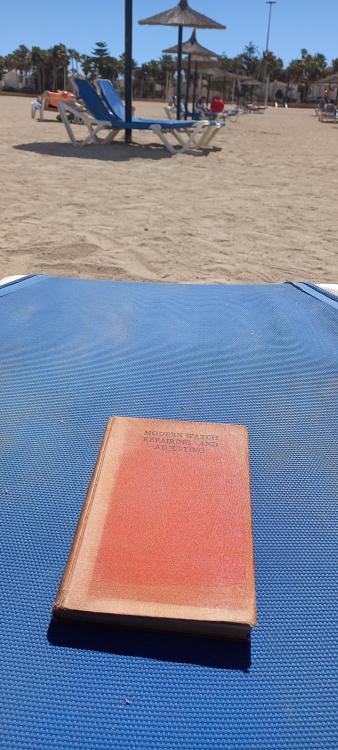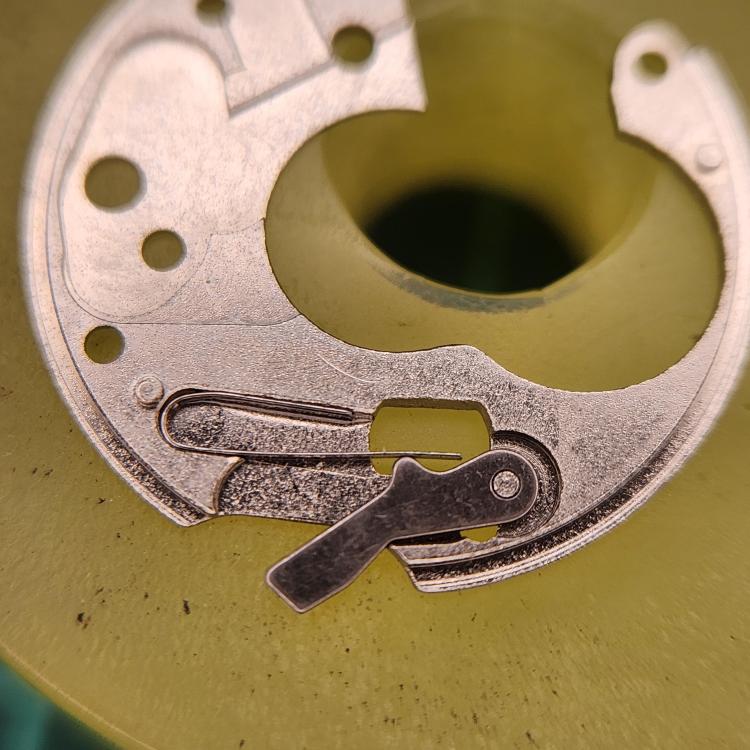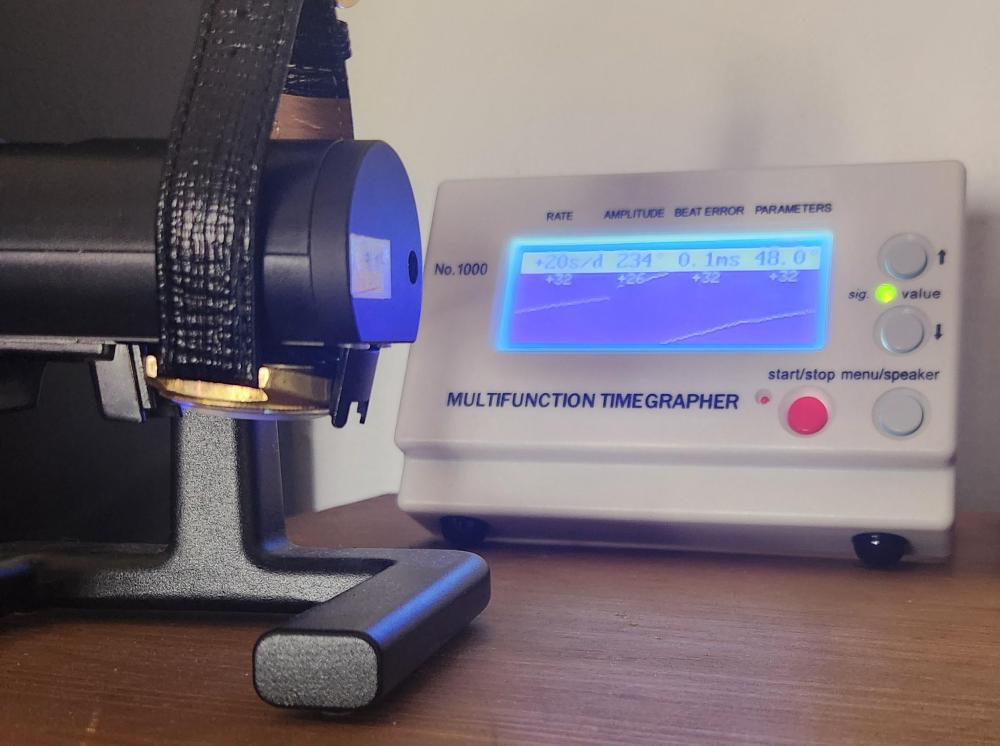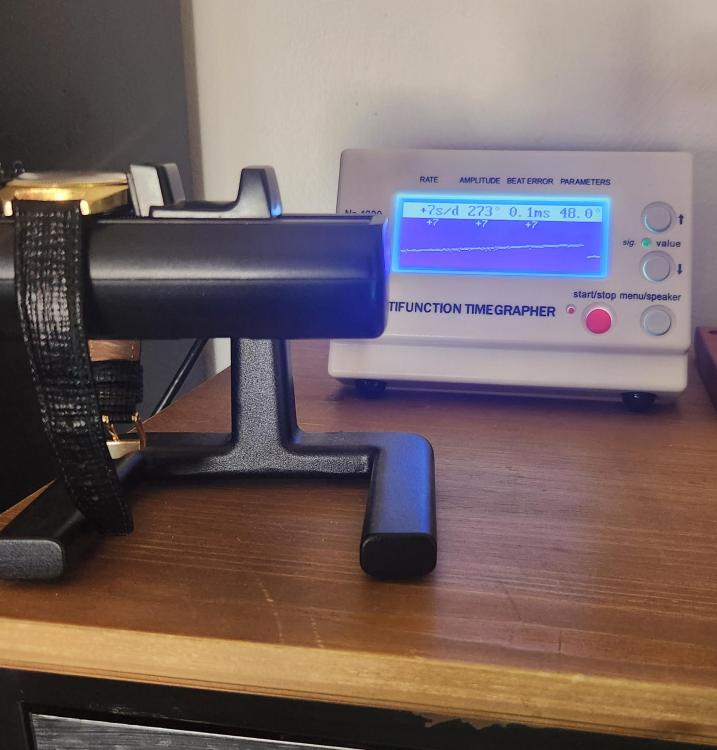Leaderboard
Popular Content
Showing content with the highest reputation on 05/19/24 in Posts
-
@steve1811uk close but no cigar I don't smoke anyway. I checked in my stock of parts and that's the closest I got to your dimensions. Good luck in your search. @RichardHarris123 I have an accumulation of all sorts of odds and ends that I acquired as a result of buying up the tail ends of old watchmakers estates. Usually after all of the great stuff has been stripped out, which means that the sweepings off of the workshop floor can be had for peanuts, but if you have the patience, can often be found to contain gold (both literally and figuratively ). These came to me through on of those purchases. I doubt that I will personally be able to make use of even 10% of my accumulated stock, but having it, and knowing what I have, means that I can at least pass bits on to those who can use it whenever possible.4 points
-
3 points
-
My thinking is yes it is better if you were to choose this or a tg, although the tg can do more . This way the watch is adjusted specifically to you and your routine. As an example i restored an old Smiths pin pallet watch ( typically an inaccurate movement ) around 3 months ago. Adjusted through 5 positions on a tg initially proved ok but not precise over time. Having then re- regulated the movement after each week of wearing over a period of 6 weeks brought the timekeeping in much closer, now within 1 minute/week3 points
-
PUW1563 is the day/date version of the 1561 (date only). I have just measured a 1561 using the old "blob of paint on the rim" technique to determine the actual amplitude by observation, and then putting it on my TG and adjusting the TG lift angle until the displayed amplitude matches the observed amplitude. I get 48°. Not a million miles away but it will have overstated the amplitude by about 20° with the TG set to 52° (I tried that as well for completeness). So with a more appropriate lift angle set on your TG you would have got an amplitude reading of about 240°.2 points
-
That's a really hot bath temperature. I don't recall ever seeing a watch-specific cleaning machine with heat available for the cleaning bath; however ones that have ultrasonic do warm the bath as a result of that. In my ultrasonic tank in which I use a similar product to the Elma, I set the heat to 35 (C), mostly because I don't tend to leave parts in long enough for it to heat from the ultrasonic action. A warm bath does tend to clean better or at least faster than a cold one. I think the ammonia in the Elma has reacted with the plating on the setting at that high temp.2 points
-
2 points
-
Hi Bob, Welcome to the forum and thank you for your service. I would never try to discourage you from getting into this wonderful hobby/profession, but please be aware, it does not cost just a few dollars to get into watch repair. Tools are expensive and in many instances the cheap knockoffs are worthless, especially when learning. You can get the tools needed to disassemble, clean, inspect, reassemble and lubricate a watch without spending thousands, but as soon as you start getting into task-specific tools, there are so many and they don’t come cheap. My suggestion is to start with the basics required to disassemble, clean, inspect, reassemble and lubricate only, and build upon that gradually as the need for other tools arises. The advice above regarding starting out on working movements is gold. Many of the non-running watches on eBay have been bought, tinkered with, deemed too difficult and then sold again, often with more damage done each time. Without experience, you clean and service a non-runner and it still doesn’t run. What now? Troubleshooting is difficult as a beginner. This can become very frustrating. I would encourage you to buy a working movement, and learn to strip and service it. If it isn’t running afterwards, you know it’s down to you, and as long as you didn’t damage anything you know that the parts you’ve got can form a ticking watch. An excellent movement to start with is the ETA 6497 clones from China, such as the ST36. They’re not expensive, and although it finds use in some larger wristwatches, this movement was originally designed for use in pocket watches, so everything is larger and easier to see and handle. Once you can service a new ST36 and have it running better than it did when it arrived, you’re definitely ready to step up to working vintage watches and then think about repair of non running or poorly running watches. As far as cleaning solutions go, you will not do better than the commercial watch cleaning and rinsing solutions that are available. You’ll find plenty of suggestions for home brew cleaners online, but the professional products are superior and you want to give yourself every advantage you can, especially when you start working on vintage movements containing hardened decomposed lubricants and often years worth of other dirt and dust. Alcohol is ok for cleaning or rinsing movement parts that don’t contain any shellac. The pallet fork and roller table contain jewels secured with shellac and will tolerate a rinse in alcohol but not prolonged exposure. Methanol dissolves shellac faster than ethanol, and isopropyl alcohol dissolves shellac slower than ethanol. Just in case you don’t know already, the radium on the dial (and likely the hands) of your Dad’s Elgin is highly radioactive. It is safe enough when safely contained within the watch case, but the moment you open the watch and especially when handling the dial or hands you must take precautions against inhaling or ingesting any radium. Best Regards, Mark2 points
-
Hi And welcome to the forum, best watches to train on are cheap but working watches as if they don’t work after your ministrations it’s your fault. Getting broken watches defeats the object. When you work on these and they don’t work afterwards you don’t know whether it’s what you did or was it knackered before you started , so try and make life easier without accumulating junk. Attached a file which is worth going through TZIllustratedGlossary.pdf2 points
-
If anyone recognizes this part, then you understand the nightmare which is the Slava 2414. The date detent lever and spring are first installed to the underside of the date cover plate, then the plate is flipped over and screwed down to the mainplate. Sounds simple enough, right. But the slightest shake or bump could launch the lever and spring into orbit. I've watched several videos on YouTube and it looks like it's the only way to do it. You can't screw in the cover plate halfway and slip the spring in, like some of the early Seikos. I've done several using this method and have never enjoyed the experience. Then it hit me.... Why don't I just glue the blasted spring to the plate. So I used a hard setting UV glue and glued the short tail of the spring to the plate. And viola! Problem solved.1 point
-
Thank you Marc! I re ran the TG. First I went ahead and checked the balance jewel on the regulator and it was bone dry. I cleaned and oiled it, not without some drama including pinging the capstone and searching my bench with a black light for 30 minutes and finally shone it on my face and looked in the mirror only to find it on my left cheek in my 2 day growth! Back in and on the Grapher we are at 275. However significant drop in DD (234) and CR (190 edited) positions tells me it's time for a complete cleaning and oiling.1 point
-
I have seen videos where the servicing seems of a good standard but did nothing with the case, spoiled everything. Why leave the case in such a poor condition?1 point
-
Specific gravity is now called relative density. Set water at 1 and compare solids and liquids to it. The density if brass is appropriately 8500 kg/m³ so it's relative density is 8.5 etc. Gasses are compared to air, air equals 1.1 point
-
Looks like your doing it correctly, trying a light Polish of the mating surfaces, clean of and try again.1 point
-
The only reaction I can think of offhand where a silver (and non-ferrous) metal rapidly turns black without extreme heat is with actual silver? If there was any sulphur based material in the liquid, that could possibly produce black silver sulphide/ >google< OK, looking at the Elma Red safety data sheet, it contains sodium cumenesulphonate and potassium cumenesulphonate. The silver reaction seems a possibility? If it is that, it can be converted back to silver by bubbling hydrogen over it; hold it over some shredded aluminium foil in a washing soda solution - as long as that will not harm any other part of the plate? (That's an old trick to avoid taking the surface off tarnished silver or silver plated items when cleaning them).1 point
-
Specific gravity, an old unit of density. The Specific gravity of water is 1 so the benzene is less dense.1 point
-
Excellent post and advice @Mercurial I agree with everything you say. Yes, this is important to understand. The good thing is that you can start pretty slowly and then if your interest grows, increase the number of tools. I wouldn't be surprised if I've spent the equivalent of one or two good Rolex Submariner watches since I started eight years ago. The nice thing is that I appreciate my tools at least as much as my watches. There is something truly magical about using a well-used patinated Swiss quality tool that a skilled watchmaker used for decades. Again, excellent advice, and when you want to go wristwatch size but still not take any financial risks I'd recommend Vostok 24xx movements such as Vostok 2409. Most modern watches, less than 60/70 years or so, seem to secure the impulse jewel with friction only so that should be safe to rinse in IPA (isopropanol, not Indian Pale Ale). I've never handled Radium but Kalle Slaap made an interesting video about it some time ago. As I understand it, it's the dust that can "kill" you. https://youtu.be/Z-A-e8zSoOM1 point
-
Hello and welcome from Leeds, England. There us no such thing as a stupid question, ask away, that's what we are here for.1 point
-
As it is your watch the answer is yes! When regulating a watch for someone else there's no way we can tell in what environment the watch is used and how often the wearer of the watch will wind it. In that situation, a timing machine is a handy tool to get close to something that likely will be acceptable. As indicated by @tomh207 and @clockboy a timing machine is a great way to quickly determine the health of the movement. If you are considering a Weishi I'd recommend the 1900 model over the 1000 model as the 1900 has a gain setting. These machines work well but aren't foolproof. If you want something more advanced I'd recommend the PCTM software from @praezis.1 point
-
Agree with Tom, a timegrapher shows more than regulation. Such as beat error. Also with a timegrapher you can regulate in different positions to get a better average.1 point
-
Best is to combine the 2, timegrapher regulation 48 and 72 hours after servicing then wear for a week to confirm or return to regulation as you have done above. The timegrapher will get you to a good standard and has the bonus of showing if there are any residual issues, however is only part of the story when practical timekeeping is thought about. Tom1 point
-
I've bought brands like Citizen, Seiko, Titoni, Tissot, Roamer. Strange thing is many of them were using ST96 movements. I'm not sure if the ST96 is original to that model or whether it was a replacement movement. All the watches with nice looking dials were obviously refurbished, after-market dials. And all of them had over-polished watchcases. Some of them had non-original hairsprings, rejewelled pallet forks, watch crystals that don't fit and glued in with a generous amount of glue. One of them was totally not working because the pallet jewel was loose to the point that it almost fell off. But the sellers were very nice. The seller of the non-working watch gave me a complete refund. Some of them gave partial refunds. I would say don't by luxury watches on the internet, regardless of the country the seller is from. Don't believe the "serviced by master watchmaker" statement. Have realistic expectations. ( Do expect the occasional complete junk.) Do expect to do a complete overhaul and major repairs. Otherwise, watches from Mumbai are great. For clocks.... I'm not so sure.1 point
-
Interesting interpretation of "traditional". I would say that Loctite is definitely the up-to-date and appropriate stuff to use, however, it is a relatively modern solution. Before the advent of such esoteric solutions I believe that the "traditional" thread locker of choice may well have been a sugar solution. Once applied the water would evaporate and the sugar would crystalise, locking the threads tight.1 point
-
As an alternative, clear nail Polish, the advantage is you can have a manicure at the same time.1 point
-
Unfortunately yes! Magnetism can wreak havoc on a mechanical watch movement if the balance hairspring becomes magnetised. The cheap blue Chinese demagnetise-rs are useless if you feed them the wrong voltage (> 110 V), and even so, they don't work very well. The one I got when I was new worked so poorly that it drove me nuts. Eventually, I was lucky to get a Greiner Magnomatic for a little money. It's an amazing tool that can be trusted to do its job perfectly in seconds. A new one comes with a price tag of £885 excluding tax and shipping, and if you think that's a bit steep (I believe most of us would) and can't find a used one I'd go with @Jon's recommendation.1 point
-
1 point
-
Thanks to everyone for your help. I am simply amazed at the knowledge of you folks. You are all truly "watchmasters".1 point
-
1 point












